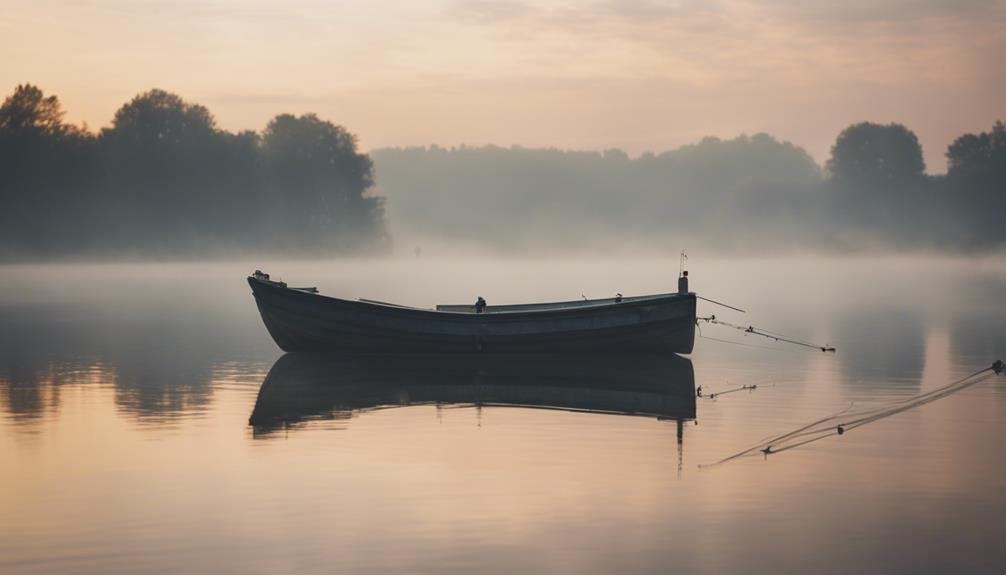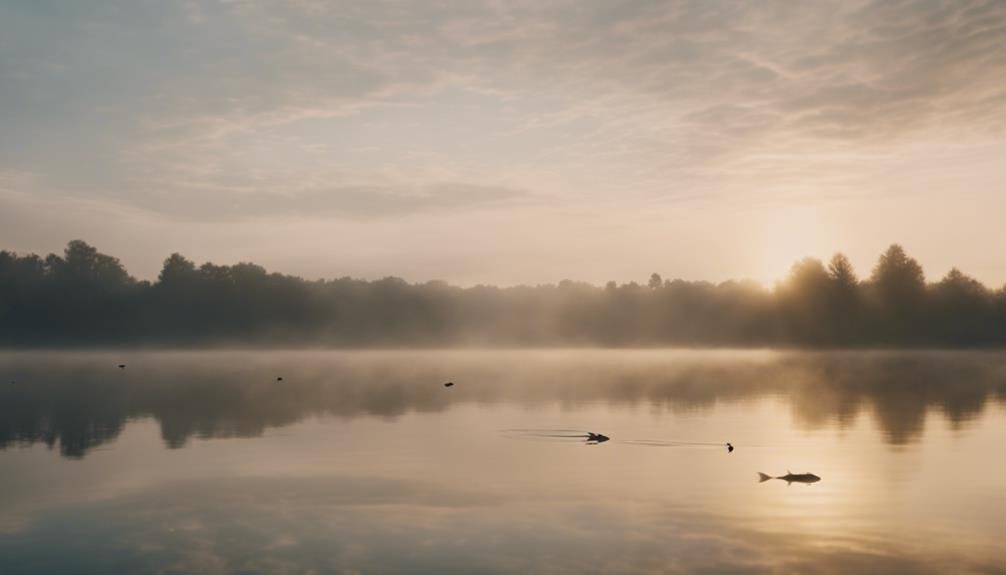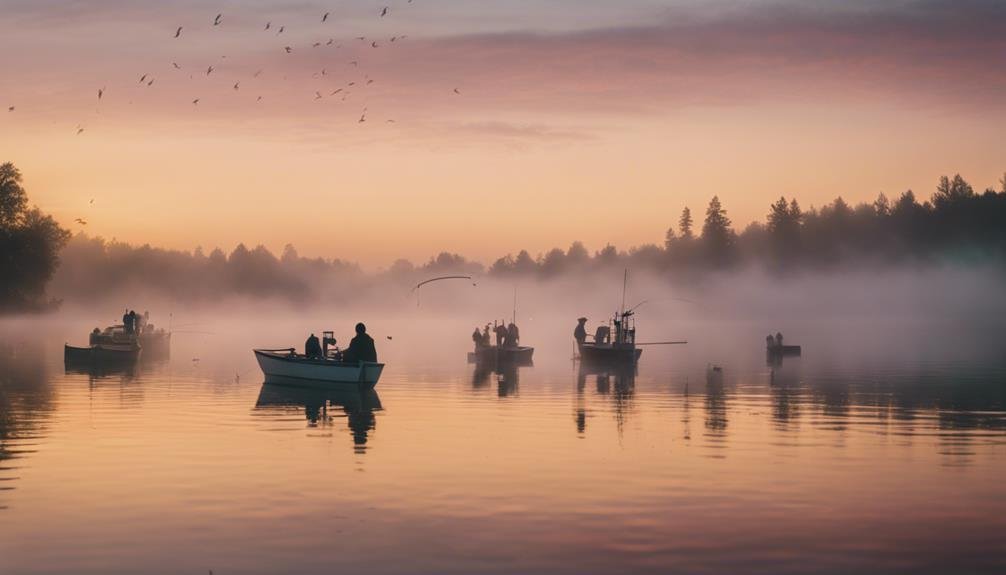Understanding the best barometric Pressure can be a game-changer on your fishing trip. Fish tend to respond to changes in Pressure, and knowing when it’s within its ideal range of 29.90 to 30.90 inches can greatly boost your catch rate. Rapidly falling Pressure usually means fish are more active, while stable Pressure can allow you to experiment with different baits and lures. But how do these pressure changes impact fish behavior, and what should you look for to optimize your time on the water?
Key Takeaways
- The best barometric Pressure for fishing is between 29.90 and 30.90 inches.
- Rapidly falling Pressure within this range indicates highly active fish and improved fishing conditions.
- Stable pressure periods are ideal for trying different baits and lures.
- Low Pressure drives fish to shallow areas where they actively feed.
- Monitoring pressure trends online or with a barometer helps plan successful fishing trips.
Understanding Barometric Pressure

Barometric Pressure, the weight of the atmosphere pressing down on the Earth, plays a significant role in fishing success. Understanding how Pressure affects fish behavior can give you a considerable advantage.
When barometric Pressure is high, fish tend to be less active. The increased Pressure pushes more water into their swim bladders, making them uncomfortable and less likely to feed.
Conversely, falling barometric Pressure can signal a prime fishing opportunity. As the pressure drops, fish become more active and are more likely to bite. The decreasing Pressure makes them feel lighter and more comfortable, triggering their feeding instincts.
Monitoring these pressure trends can be essential. Rapidly falling Pressure indicates an approaching weather change, which can make fish even more greedy.
When the Pressure is stable, it’s perfect for testing different lures and baits. Fish are moderately active during these periods, allowing you to experiment and find the ideal bait.
Understanding these pressure patterns and their effects on fish behavior allows you to optimize your fishing strategy, leading to more successful outings on the water.
Ideal Pressure Range
To maximize your fishing success, an ideal barometric pressure range that encourages fish to bite. The best barometric Pressure for fishing typically falls between 29.90 and 30.90 inches. When you check the barometric Pressure within this range, you see something active and feeding.
Rapidly falling Pressure Pressure this range is a golden opportunity, as it often signals improving weather that makes fish more inclined to bite.
To stay ahead, you should keep an eye on the pressure trends. Monitoring the barometric pressure can help you plan your fishing trips more effectively. You can use the barometric pressure when conditions are most favorable for fishing.
During fair weather, the Pressure Pressure remains within the ideal range, supporting normal fishing activities. However, when the Pressure Pressureapidly, it’s your favorite spot for the best fishing experience.
Effects on Fish Behavior

Understanding how changing barometric pressure fish behavior can greatly enhance fishing success. When the barometric pressure fishing, it directly impacts how fish behave and feed.
High Pressure Makes fish less active, causing them to move to deeper waters and slow their feeding behavior. On the flip side, low Pressure makes fish more active and increases their feeding activity, making these periods prime times for casting your line.
Rapidly falling pressure signals that fish are most active and feeding frenetically, offering the best conditions to catch more fish. However, remember that different species show varying sensitivity to pressure changes. Some fish might react strongly to even minor fluctuations, while others are less affected.
To visualize how barometric Pressure fish behavior, consider these scenarios:
- 🎣 High Pressure: Fish swim sluggishly in deeper waters.
- 🌿 Low Pressure: Fish rise to shallower waters, actively feeding.
- ⬇️ Rapidly falling Pressure: Fish are highly active and biting aggressively.
- 🐟 Species sensitivity: Trout may react differently than bass to pressure shifts.
- 📈 Monitoring pressure trends: Adjust your fishing strategies based on pressure patterns.
Monitoring Pressure Trends
Tracking pressure trends helps you pinpoint the best times to fish, maximizing your chances of success. Monitoring PressurePressureees, you’re you’ryou’reeyou’reofg conditions that influence fish behavior.
One of the most effective ways to do this is to use a hand-held barometer for real-time tracking. This tool allows you to monitor pressure trends and adjust quickly during fishing trips.
Understanding these trends is essential for identifying ideal fishing conditions. Rapidly falling Pressure Pressure increases fish activity, presenting a prime opportunity for fishing success.
Knowing that the perfect barometric pressure typically falls between 29.90 and 30.90 helps you plan when to hit the water or change your tactics.
Fishing Strategies

When fishing, adjust your bait presentation based on barometric Pressure to Increase your chances of success. High Pressure results in bluebird skies, making fish slightly active and pushing them deeper. Your best bet is fishing slowly in deeper water.
On the other hand, degrading weather with falling pressure is more aggressive and likely to feed.
Here’s Here’Here’snHere’sfferentan affect fishing and your strategies:
- Clear Skies: Fish are less active; slow down your bait presentation.
- Degrading Weather: Fish become more aggressive; use faster lures.
- Bluebird Skies: Fish deeper; they tend to seek cooler, deeper water.
- Moving in a Favorable: Pressure shifts can lead to good fishing windows.
- Best Time to Test Lures: Experiment with different lures using varying conditions.
Use barometric PressurePressurere out the best times and methods. High Pressure? Fish slowly in deeper water. Low Pressure? Fish might be more active near the surface. For real-time data, utilize barometric pressure apps and consult local fishing guides.
Be adaptable, and you’ll be able to condition yourself to a fishing advantage.
Conclusion
To sum up, grasping barometric PressurePressureatly enhance your fishing success. Aim for a pressure range of 29.90 to 30.90 inches, and monitor trends with a barometer or online tools.
Remember, rapidly falling PressurePressureore fish activity. During stable periods, experiment with different baits and lures. Adapting your strategies based on pressure changes will increase your chances of landing that big catch.

